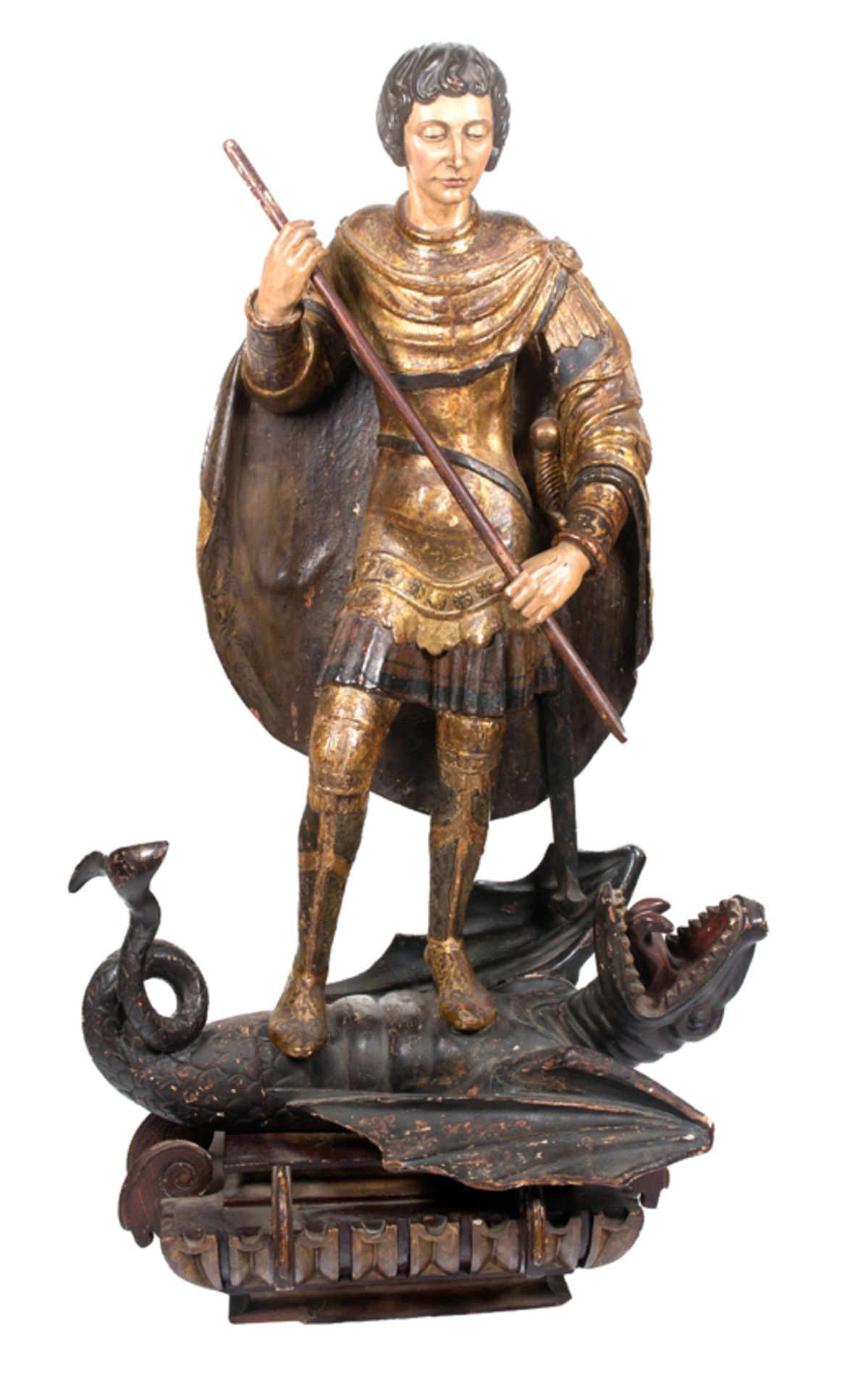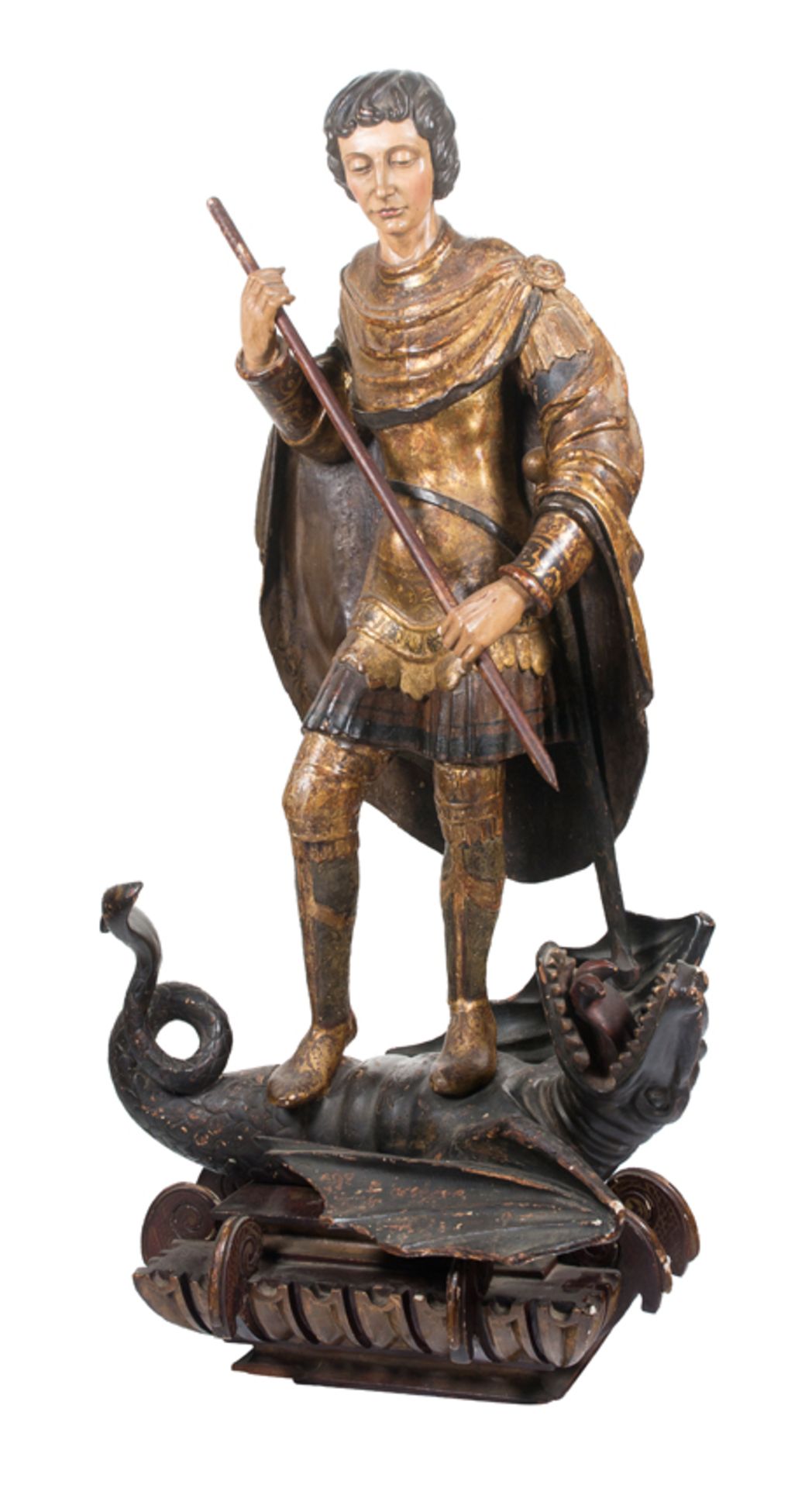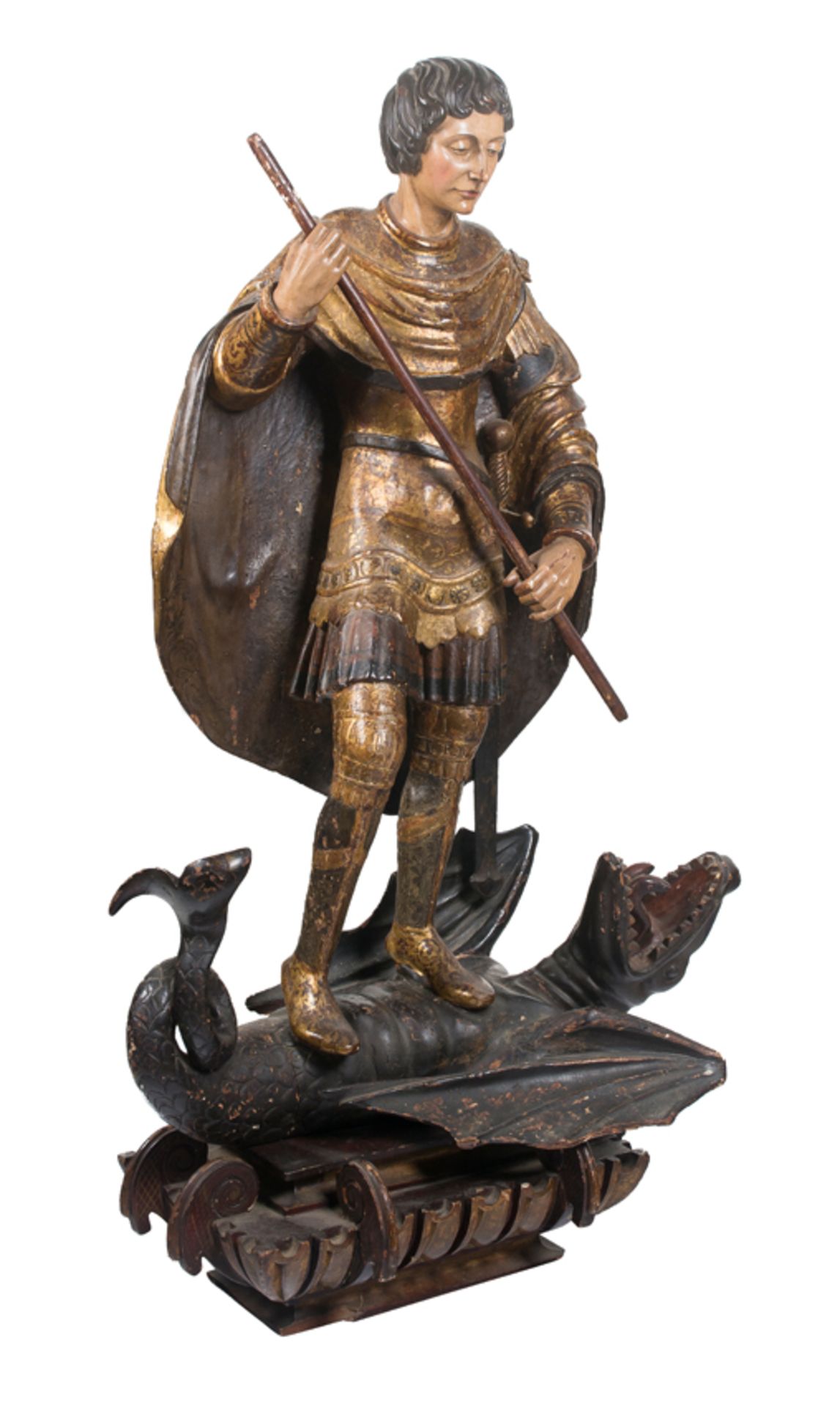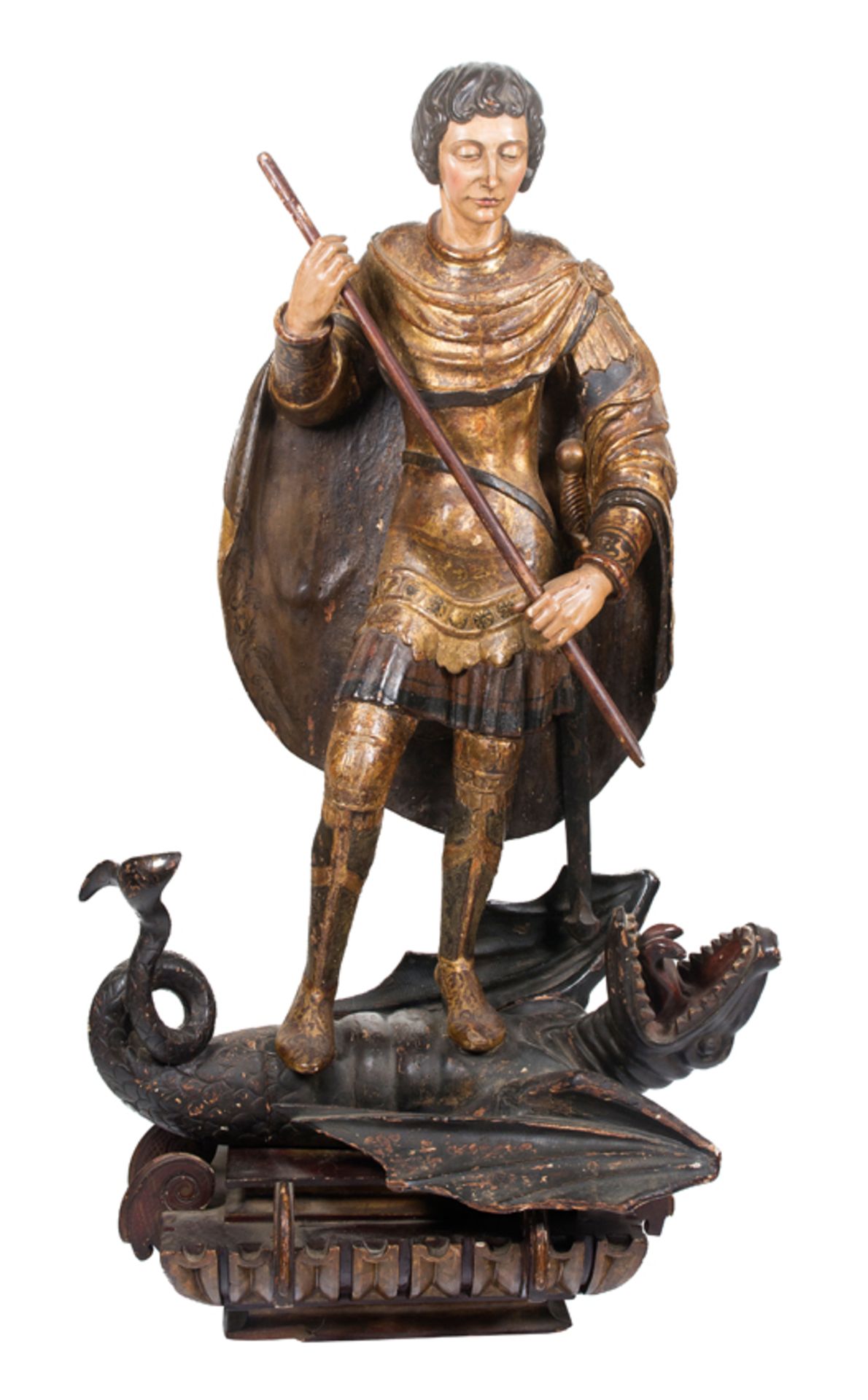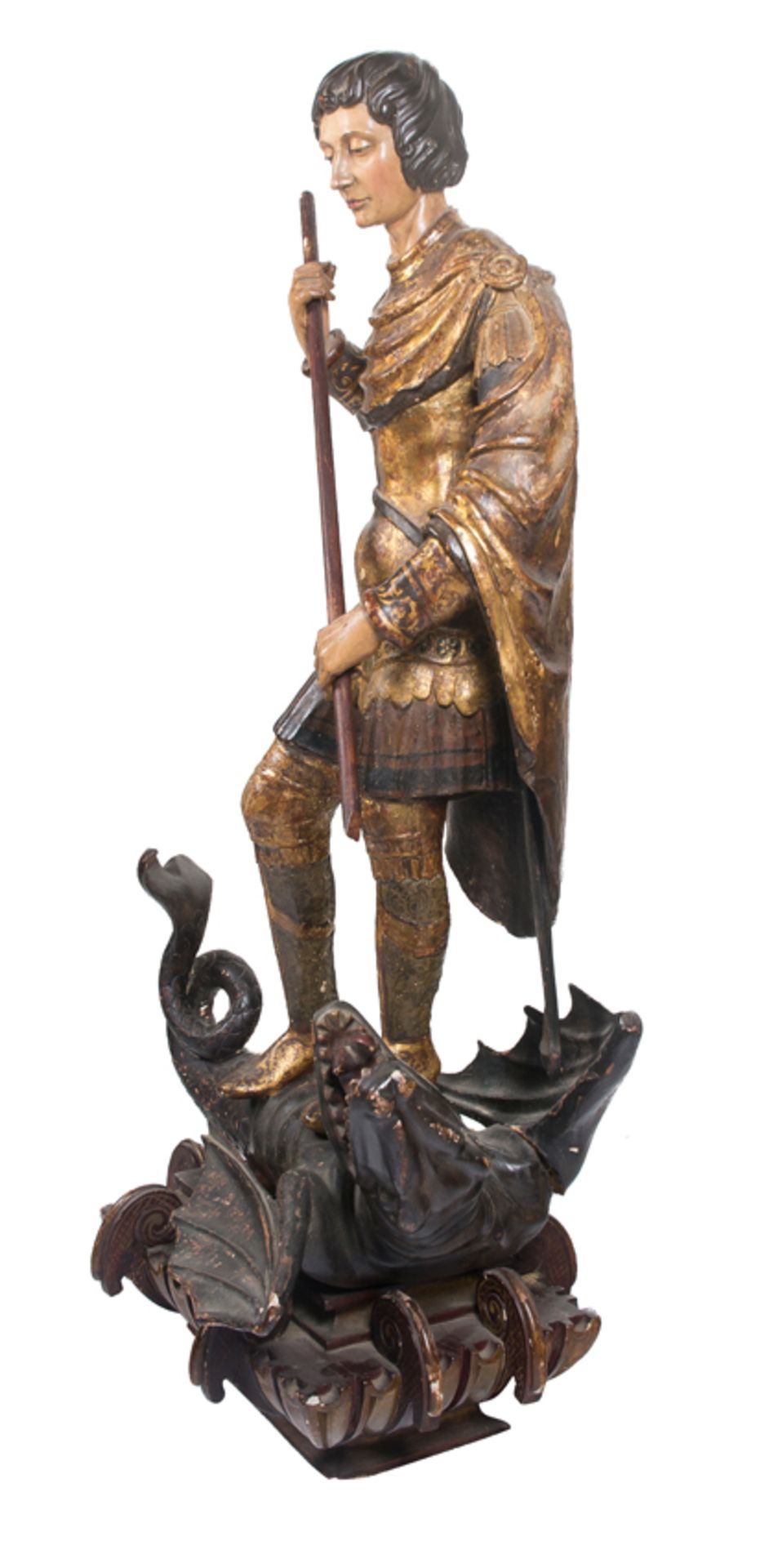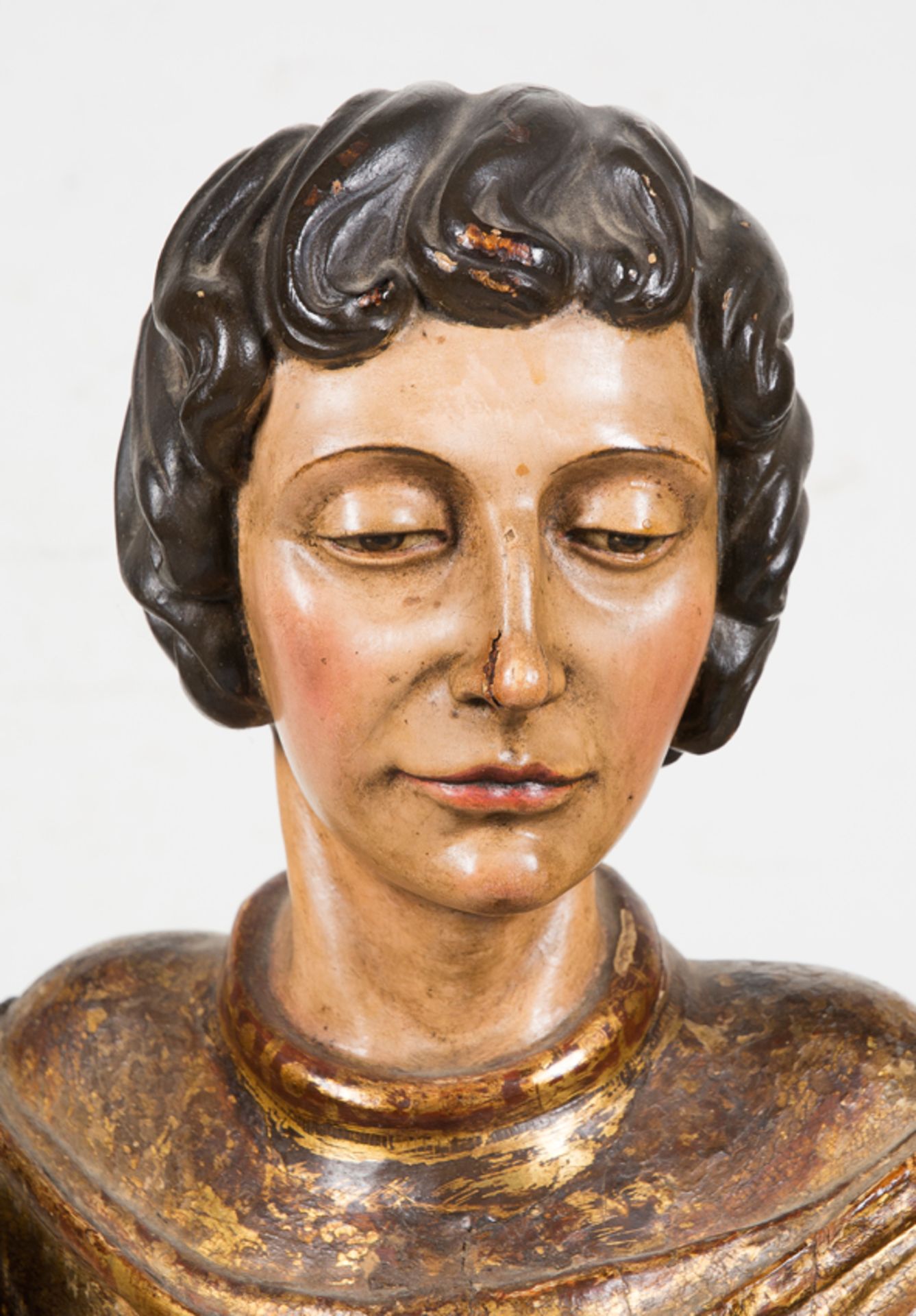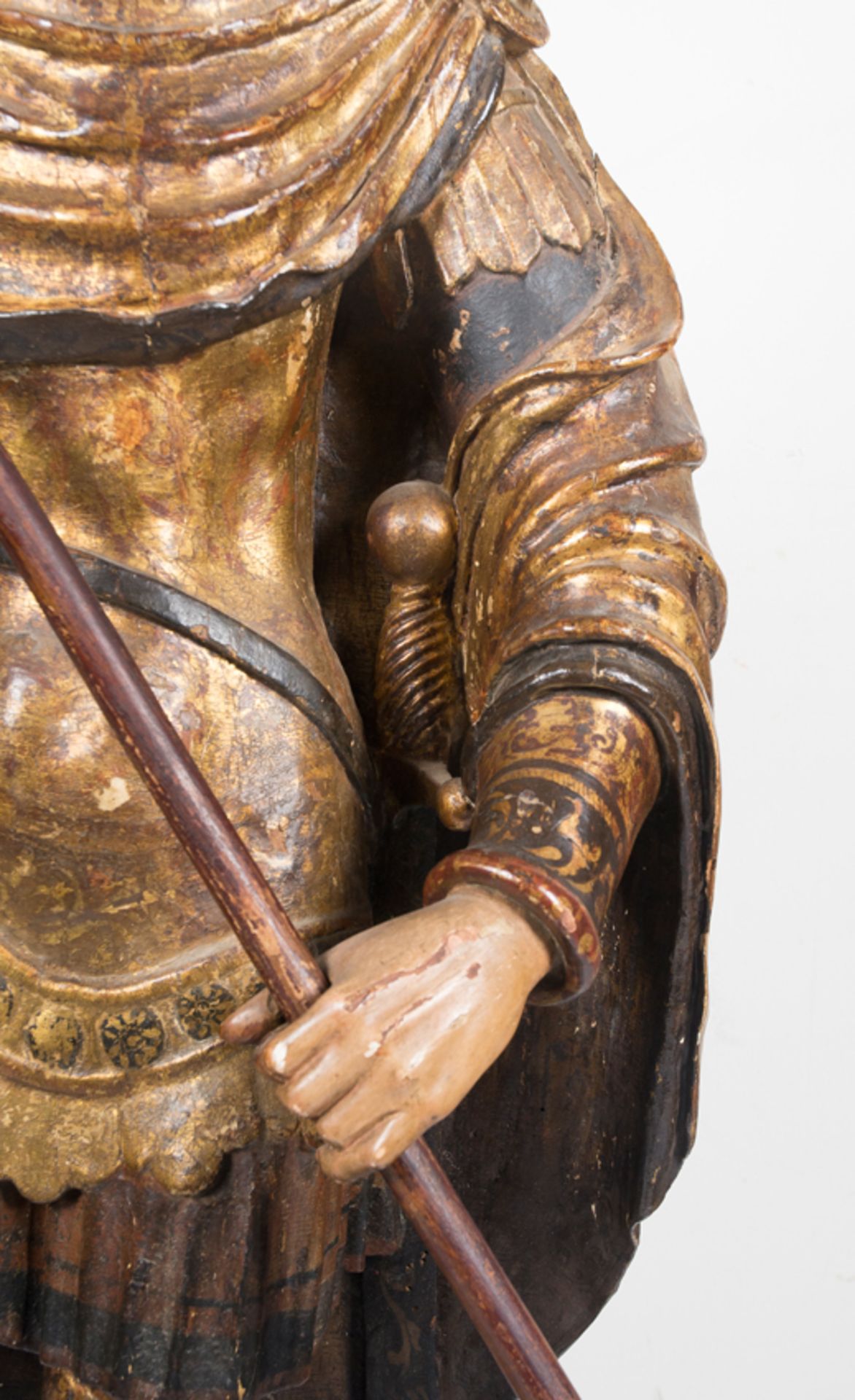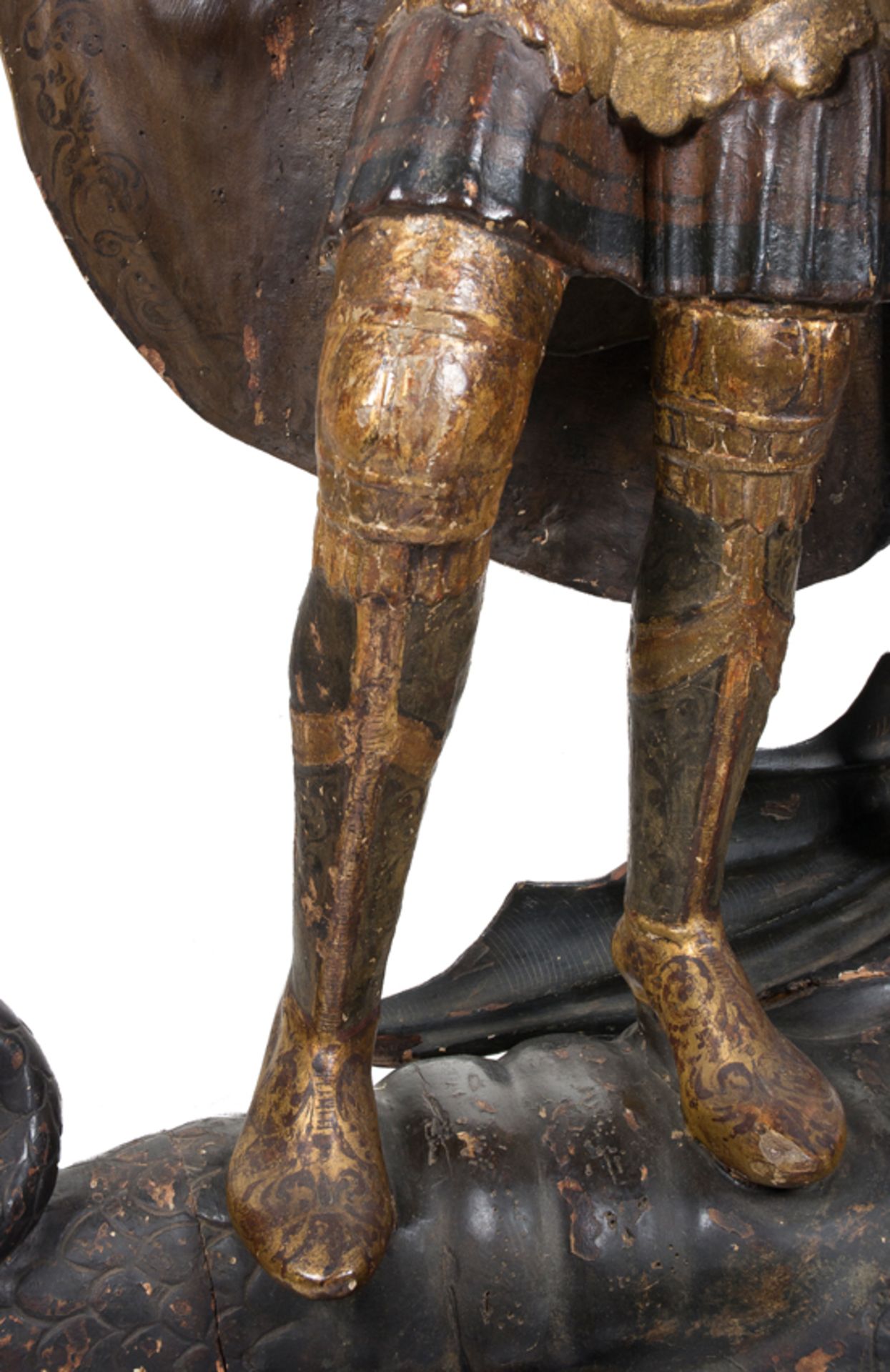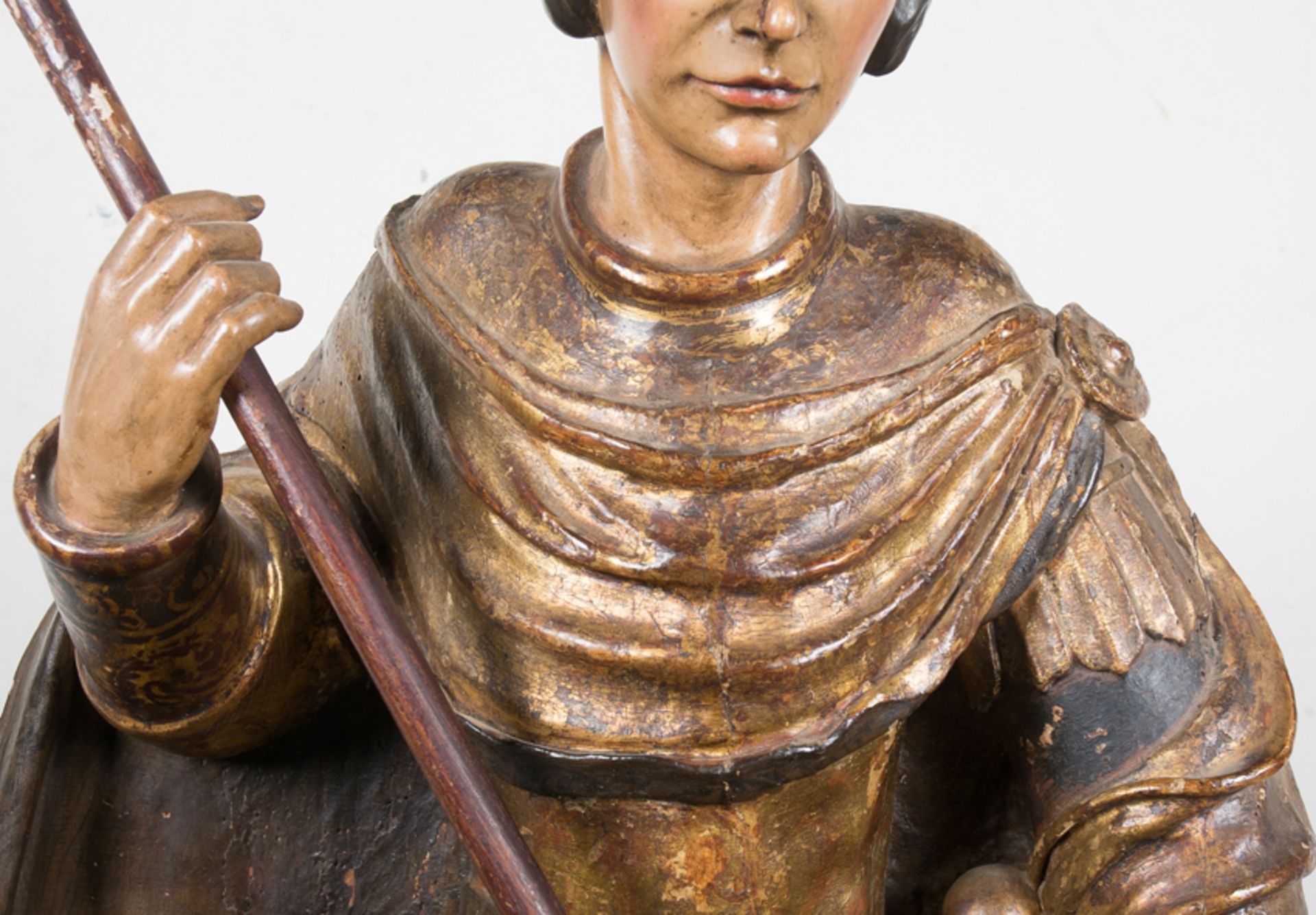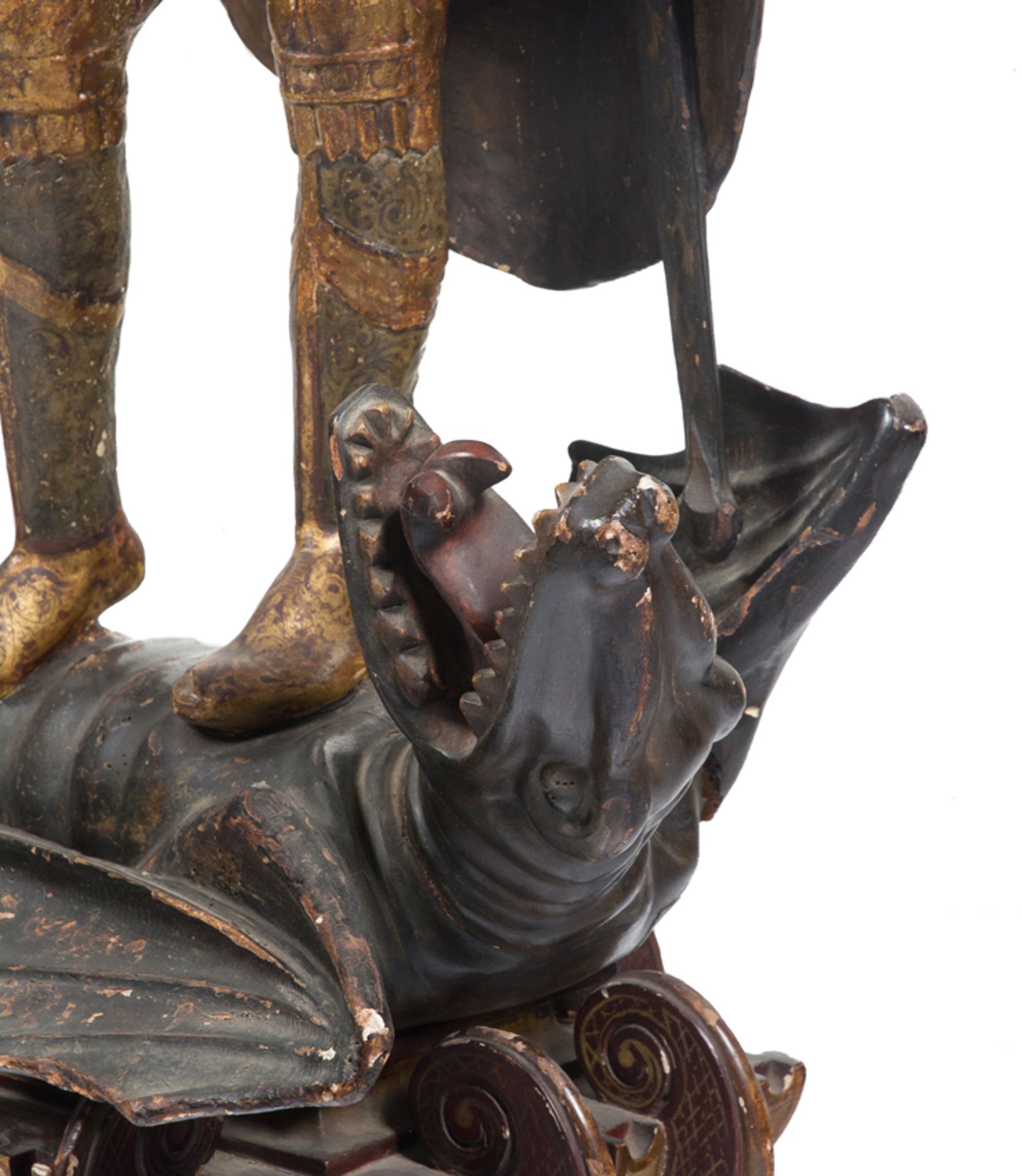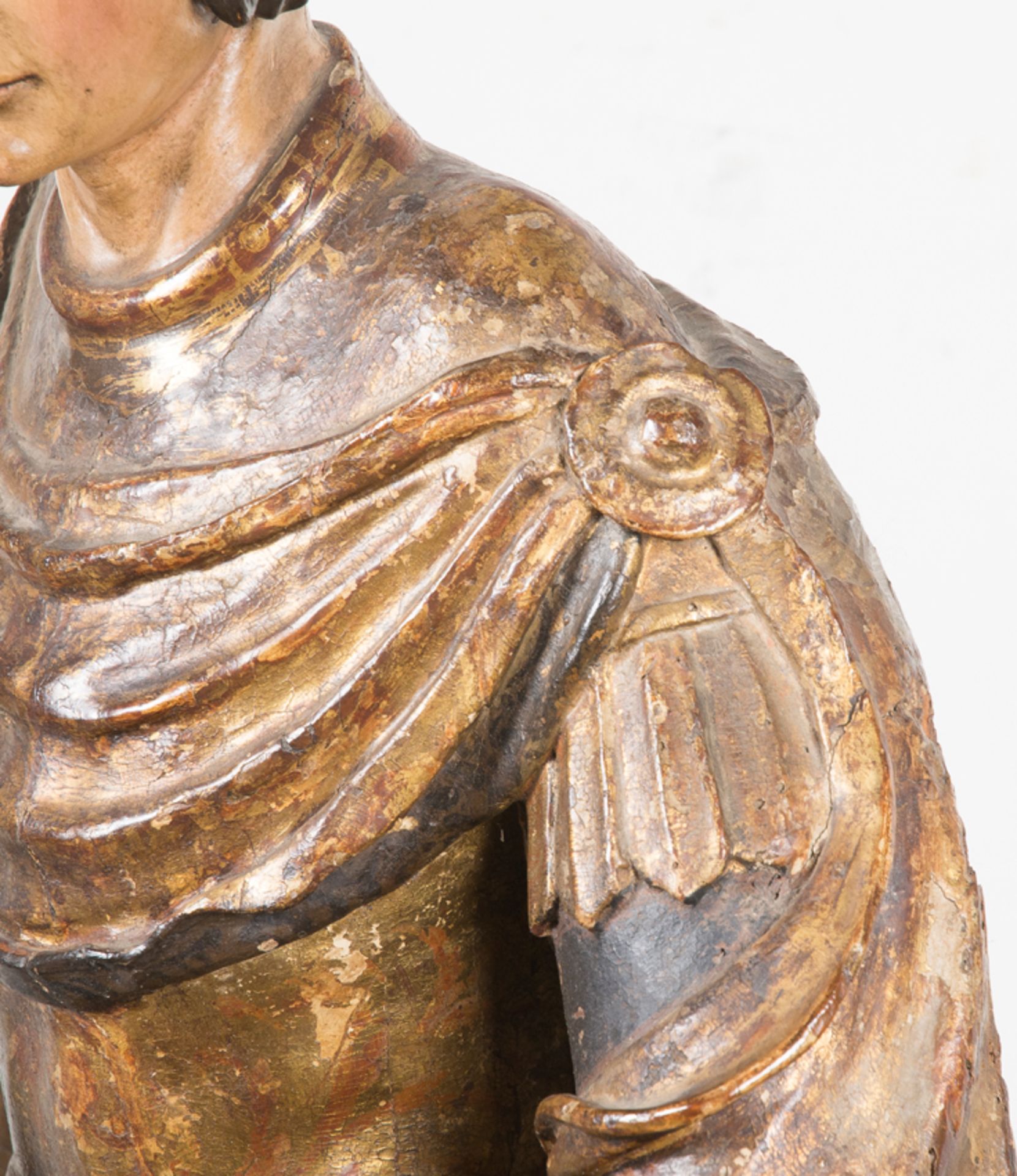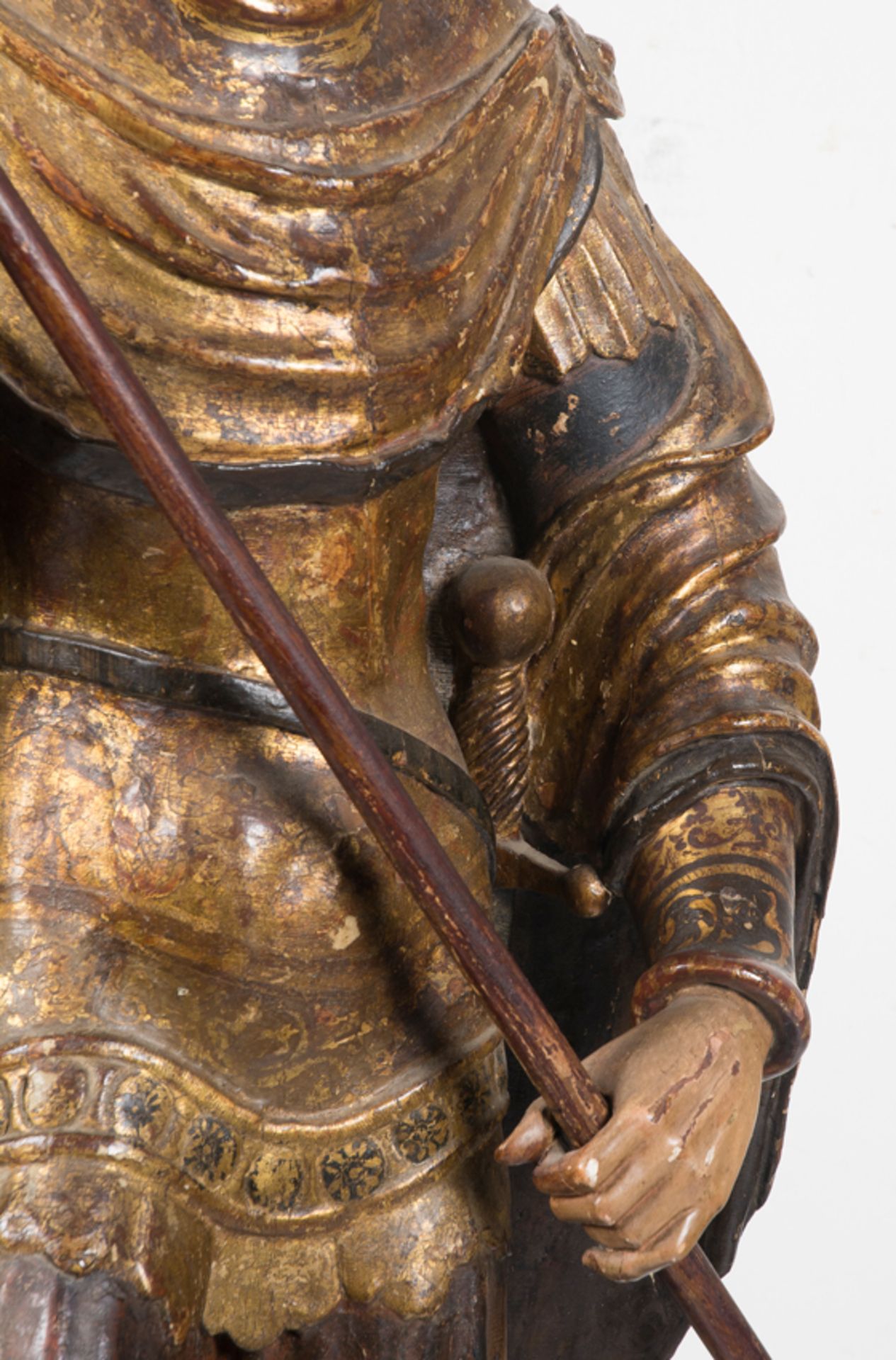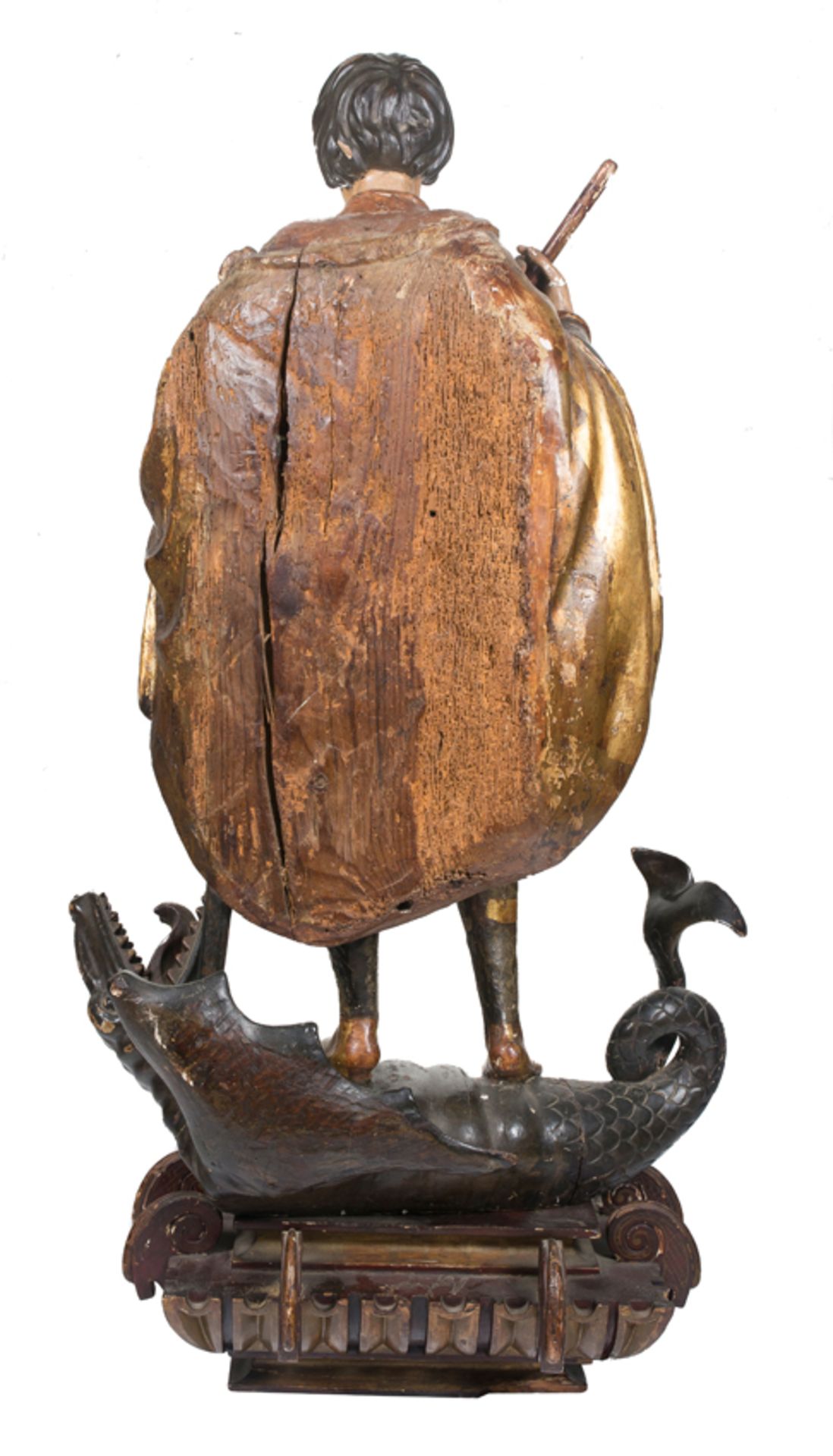13
"Saint George". Carved and polychromed sculpture with "estofado" technique. Spanish School. First th
"Saint George". Carved and polychromed sculpture with "estofado" technique. Spanish School. First third of the 17th century. Figure measurements: 94 x 41 x 29 cm. Total measurements: 122 x 65 x 39 cm. This curious and exquisite sculpture of Saint George defeating the dragon was undoubtedly made for a reredos, as the back has not only not been worked, but also it has not been polychromed or gilded either, which tells us that this part of it would not have been on display to worshipers. Saint George was a Roman soldier whose legend, and, more specifically, that relevant to his battle with the dragon, was partly recognised by Jacobus de Voragine in his famous Golden Legend. The depictions of the saint have a certain stylised canon. He has been portrayed as a warrior at the point of finishing off his enemy. Thus, he stands in a rather static position on the dragon’s thorax, which he is at the point of killing with the lance he is holding in both hands. His right leg is slightly bent to bring a little movement to the composition, which the uneven arrangement of the hands contributes to, as they make a diagonal which ends in the dragon’s mouth. The saint wears gilded armour which has been richly decorated with estofado, under which a short tunic with long sleeves can be seen and a cape with curved folds which are fastened with a brooch placed on the left shoulder. His torso is covered with a type of breastplate which is fitted to his body and defines his anatomy; a series of bracelets or coiled bangles, all in golden tones with a border of painted, stylised vegetation elements. The folds in the armour and tunic are treated with some naturalism. Behind the left arm a large sword can be seen with a gilded hilt, which adds to his soldier or warrior character. The saint’s face, which betrays a certain softness in the cheeks and the chin, is meticulously modelled, meaning that each of the features has been portrayed with great detail, as has the lush hair which falls in ringlets over his forehead. The heavy-lidded eyes are noticeable as they appear to show tiredness in his countenance. The dragon, which is fighting back, opens its mouth full of serrated teeth with a forked tongue. Its body is a mix of different beings: it has a dragon’s head, bat’s wings and a scaly, snake-like tail with a life of its own which is rising up to bite the saint. The set, and especially the face, show a series of characteristics which allow us to date it to the first third of the 17th century. The classical style plinth, decorated with two scrolls on each of its sides, also suggests the same chronology. There is the remote possibility that this is not actually a depiction of Saint George, which is doubtful as the enemy he is facing is a dragon with an entire body, which normally denotes Saint George. When the beast has at least one human part in its body it denotes a portrayal of Saint Michael. This question deepens when considering the fact that on the upper part of the back there is an orifice, present in numerous baroque effigies of Saint Michael, in which wings that were made independently from the body could be inserted. The portrayal of Saint George was at its zenith from the late classical era until the beginnings of the early modern period, and he is also the patron saint of certain lands, meaning that depictions of him continued to be made, for example, in the lands of the Crown of Aragon, where the origins of his patronage come from the legend in which Sancho Ramírez’s troops defeated the enemy in the Battle of Alcoraz (1096) due to the saint’s miraculous intervention. This miracle has a parallel in the miraculous intervention of Saint James the Moor-slayer in the Battle of Clavijo (844) in the lands of the Crown of Castile. This suggests that the sculpture could have come from a workshop situated in a town in the former territory of the Crown of Aragon. However, we cannot rule out the idea that it might have been made by a Castilian master.We would like to thank Javier Baladrón, doctor in History of Art, for identifying and cataloguing this piece.
"Saint George". Carved and polychromed sculpture with "estofado" technique. Spanish School. First third of the 17th century. Figure measurements: 94 x 41 x 29 cm. Total measurements: 122 x 65 x 39 cm. This curious and exquisite sculpture of Saint George defeating the dragon was undoubtedly made for a reredos, as the back has not only not been worked, but also it has not been polychromed or gilded either, which tells us that this part of it would not have been on display to worshipers. Saint George was a Roman soldier whose legend, and, more specifically, that relevant to his battle with the dragon, was partly recognised by Jacobus de Voragine in his famous Golden Legend. The depictions of the saint have a certain stylised canon. He has been portrayed as a warrior at the point of finishing off his enemy. Thus, he stands in a rather static position on the dragon’s thorax, which he is at the point of killing with the lance he is holding in both hands. His right leg is slightly bent to bring a little movement to the composition, which the uneven arrangement of the hands contributes to, as they make a diagonal which ends in the dragon’s mouth. The saint wears gilded armour which has been richly decorated with estofado, under which a short tunic with long sleeves can be seen and a cape with curved folds which are fastened with a brooch placed on the left shoulder. His torso is covered with a type of breastplate which is fitted to his body and defines his anatomy; a series of bracelets or coiled bangles, all in golden tones with a border of painted, stylised vegetation elements. The folds in the armour and tunic are treated with some naturalism. Behind the left arm a large sword can be seen with a gilded hilt, which adds to his soldier or warrior character. The saint’s face, which betrays a certain softness in the cheeks and the chin, is meticulously modelled, meaning that each of the features has been portrayed with great detail, as has the lush hair which falls in ringlets over his forehead. The heavy-lidded eyes are noticeable as they appear to show tiredness in his countenance. The dragon, which is fighting back, opens its mouth full of serrated teeth with a forked tongue. Its body is a mix of different beings: it has a dragon’s head, bat’s wings and a scaly, snake-like tail with a life of its own which is rising up to bite the saint. The set, and especially the face, show a series of characteristics which allow us to date it to the first third of the 17th century. The classical style plinth, decorated with two scrolls on each of its sides, also suggests the same chronology. There is the remote possibility that this is not actually a depiction of Saint George, which is doubtful as the enemy he is facing is a dragon with an entire body, which normally denotes Saint George. When the beast has at least one human part in its body it denotes a portrayal of Saint Michael. This question deepens when considering the fact that on the upper part of the back there is an orifice, present in numerous baroque effigies of Saint Michael, in which wings that were made independently from the body could be inserted. The portrayal of Saint George was at its zenith from the late classical era until the beginnings of the early modern period, and he is also the patron saint of certain lands, meaning that depictions of him continued to be made, for example, in the lands of the Crown of Aragon, where the origins of his patronage come from the legend in which Sancho Ramírez’s troops defeated the enemy in the Battle of Alcoraz (1096) due to the saint’s miraculous intervention. This miracle has a parallel in the miraculous intervention of Saint James the Moor-slayer in the Battle of Clavijo (844) in the lands of the Crown of Castile. This suggests that the sculpture could have come from a workshop situated in a town in the former territory of the Crown of Aragon. However, we cannot rule out the idea that it might have been made by a Castilian master.We would like to thank Javier Baladrón, doctor in History of Art, for identifying and cataloguing this piece.
Millésime 22 · Medieval & Colonial Art
Auktionsdatum
Ort der Versteigerung
Generelle Versandinformationen vom Auktionshaus verfügbar
The purchase price includes the delivery of the lots in the venue of the auction. Transporting to other destinations is at the own risk of the client. The customer must contact "LST", to give the corresponding instructions for such transporting. "LST" is not responsible for the packaging or any accident incurred during transportation.
Wichtige Informationen
Millésime, (a French numeral which expresses the number "a thousand" for small and carefully made creations) is our desire to remember and celebrate once again, and at last, the roaring twenties of last century, with the return to a printed and meticulously prepared catalogue. It comprises a selection of works of art that have been chosen with care for their rarity, beauty, quality and also simply because we would like to make a gesture of thanks to everyone who has trusted us and our work over the last thirty years, and to those who make it possible for La Suite, our dream, to carry on.
With Millésime 22 we begin a series which we hope will repeat at the beginning of every year, at least throughout our beloved twenties.
Art, in all its facets, feeds the spirit and makes us better. Long live literature, music and art!
Dedicated to our marvellous daughter Lúa who gives sense to everything.
Beatriz du Breuil and Rafael Adrio
La Suite Subastas
AGB
CONDITIONS OF THE AUCTION:
I. REGISTRATION. To bid in the room customers must register at the beginning, filling out a form and picking a number that will identify them during the auction. Customers may be required to register in bank references or other guarantee system and if they do not prove the solvency "LST" will not accept bids and award the auction.
II. WRITTEN BIDS. "LST" will accept written bids, which will be formalized in the form provided by the room until the day before the auction. In such auctions, the room will bid in name of the client until the maximum stated in the offer and always at the lowest possible price. If there are two or more bids for the same amount, the one placed first will have the priority. Written bids received in advance, will have priority on the day of the auction.
III. TELEPHONE BIDS. "LST" will allow telephone bids, if interested people contact "LST" days before the auction providing personal data, ID card and the phone number which will be used by the staff of "LST" to call at the time of the auction. The buyer, within all the legal rights is making an offer for the asking price, when applies for telephone bid. "LST" will not take responsibility for any technical defects beyond its control, which may prevent to contact successfully the bidder during the auction.
IV. AUCTIONEER. The auction will be conducted by an auctioneer, director of the auction will be judge and arbitrator of it with full authority in its development, will award the lots to the highest bidder and is able to settle any controversy concerning lots sale, reject bids, divide lots or group them and remover objects from the room. Will be able to, if it is deemed suitable, not accept bids on the auction. His decision will be unappealable.
V. SALE OF LOTS. The lots are awarded to the highest bidder. Once the auctioneer blows the hammer, the buyer becomes responsible of the lot purchased, exempting "LST" of liability to for any damage and / or accidents that may occur. No refunds of lots.
VI. STARTING PRICE. The amount shown in the catalogue as the starting price for each lot will be, as a rule, the minimum selling price, except for exceptional cases where a reservation may be agreed upon with the seller or it set discretionary by the room.
VII. SCALE OF BIDS. The bids are set according to the following scale:
From 50.-€ to 200.-€…………………………………………..at 10.-€
From 200.-€ to 500.-€…………………………………… …25 in 25.-€
From 500.-€ to 1.000.-€………………………………..…..….50 in 50.-€
From 1.000.-€ to 2.000.-€………………………………..…100 in 100.-€
From 2.000.-€ to 5.000.-€……………………………….….250 in 250.-€
From 5.000.-€ to 10.000.-€…………………………………500 in 500.-€
From 10.000.-€ to 20.000.-€……………………………1.000 in 1.000.-€
From 20.000.-€ to 50.000.-€……………………………2.500 in 2.500.-€
From 50.000.-€ to 100.000.-€…………………………..5.000 in 5.000.-€
From 100.000.-€ to 100.000.-€………………………10.000 in 10.000.-€
From 200.000.-€ to 200.000.-€………………………25.000 in 25.000.-€
From 500.000.-€ to 500.000.-€………………………50.000 in 50.000.-€
VIII. RIGHT OF ADMISION. "LST" reserves the right to admission to the auction room and to reject, at its judgment, any purchase order, from clients whose solvency is not duly proved as well as not to sale auctions.
IX. SALE PRICES. The successful bidder of one or more lots must pay "LST" the final sale price achieves at auction, plus the 22 % plus 21% VAT on the commission, at total 26,62 % on Hammer Price.
X. CATALOG DATA. The catalogue data are obtained in order to careful research and advice, however, any responsibility is afforded about its accuracy. The lots will be auctioned in the state in which they are, not accepting any claims in restorations, breakage, damage, imperfections and, even description or numbering mistakes in the catalogue, in case of it, being the burden of the buyers to make sure before the auction that the description matches with their personal opinion about respective lot. The exhibition of the lots is intended to allow a perfect review and study of them.
XI. PAYMENT AND REMOVAL OF LOTS. Payment and removal of the lots will be held no later than five days following the auction. After this period expire without having the buyer removed the lot or lots purchases, it will accrue an expense of custody of 6 euros per day on each lot.
15 days after the auction without having the buyer paid and removes the sold lots, "LST" will inform the seller and there will begin judicial proceeding in order to obtain payment. The delay in payment by the purchaser of his/her sold lots will carry an interest increase at a rate of 1,5% per month.
XII. DELIVERY OF LOTS. The purchase price includes the delivery of the lots in the venue of the auction. Transporting to other destinations is at the own risk of the client. The customer must contact "LST", to give the corresponding instructions for such transporting. "LST" is not responsible for the packaging or any accident incurred during transportation.
XIII. RIGHT OF FIRT REFUSAL AND REPURCHASE. "LST" in order to article 38 of "Ley 16/1985 de 25 Junio del Patrimonio Histórico Español" (BOE. 155 June 29, 1985), will notify in advance to the Ministry of Culture, the content of their catalogues. Concerning the lots subject to the legislation referred to in the preceding paragraph, the Administration may exercise the rights of first refusal and repurchase according to the law. "LST" will watch over the protection of Artistic, Historical and Bibliographical Heritage of Spain. For customers out of European Community, a tax for export is required by the Administration.
XIV. VALUE ADDED TAX (I.V.A). This tax will be accrued on commissions of "LST" for buyers, using the rates prevailing on the date of the auction.
XV. DATA PROTECTION. In order to the "Ley 15/1999 de 13 de Diciembre, de Protección de Datos de Carácter Personal", the client authorize "LST", the inclusion of their data in a customer file, and for the promotion by "LST" of the objects at all times the rights of access, rectification or deletion of personal data by sending the appropriate request to the following address: LA SUITE SUBASTAS, C/ Conde Salvatierra, 8, 08006. Barcelona.
XVI. EXPRESS LEGAL JURISDICTION. These Conditions are governed by and interpreted in accordance with the rules of Spanish law. The mere act of participating in the auction as seller, buyer or bidder, implies acceptance of these Terms and Conditions.
Sales operations are understood to be held at the registered office of "LST", C/ Conde de Salvatierra, 8, 08006. Any dispute shall be taken to the competent courts of Barcelona, expressly waiving any other jurisdiction, in accordance with Article 55 of the "Ley de Enjuiciamiento Civil".




























